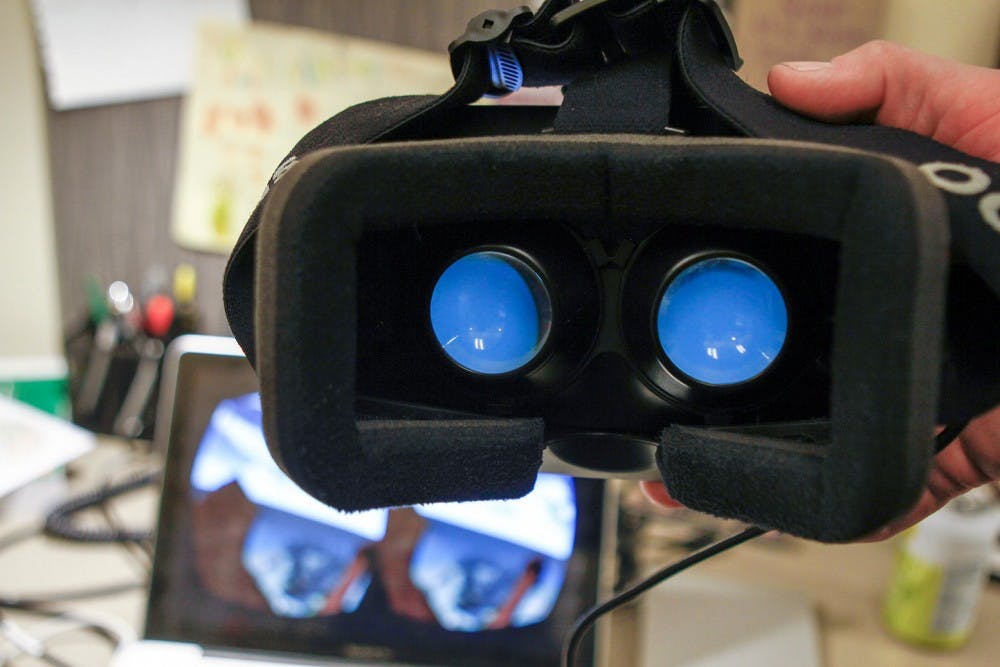New technologies lead to a more interactive experiences for individuals when it comes to watching shows or playing video games.
There are more ways than ever to tell a story.
A headset could transport you to the deep, dark depths of the ocean, the vastness of space or the middle of a battlefield. Streaming services could take you to another world for a whole afternoon, all from the convenience of a bed. Through painting or oral stories, storytelling has been a part of culture for centuries and is constantly changing with new technology. These new outlets for information change the way people consume stories — and the way producers tell them.
Virtual Reality
New immersive storytelling methods could change the experience completely, said Josh Antonuccio, co-owner and operator of 3 Elliot Studio and a lecturer in the School of Media Arts and Studies.
Antonuccio teaches an audio and storytelling class and has a trial through the media school that allows students to experience the Oculus Rift, a virtual reality headset that immerses the user into a virtual world.
“What you’re going to be seeing is the ability to create worlds that are unique or near some kind of gaming experience — like open-world things like Skyrim or Destiny — where it’s completely different because you’re in it instead of seeing it on screen,” he said.
Antonuccio researched education and virtual reality through the Patton College of Education, and together with John Bowditch of the GRID Lab, has been brainstorming how to intersect education with interactive storytelling.
“Imagine being able to take your class to a battlefield virtually and actually feel like you are there walking around or going on an archeological dig site or learn how to treat Ebola patients in a virtual hospital,” he said. “You could have virtual living textbooks that you can experience; there’s just so much possibility.”
The Expansion of TV
There have been many experiments with new forms of storytelling, but TV is “the” medium to work in, said Jack Siegel, an incoming visiting professor and current writer and producer.
Streaming services, such as Netflix and Amazon, are getting their own production companies, which means more buyers have emerged in recent years, he said.
“A 22-minute sitcom or a 42-minute drama isn’t a format that you have to comply with anymore,” he said. “There’s all sorts of short- and long-form projects ... and there is a lot more opportunity for different voices and different points of view.”
TV isn’t changing, but is “expanding,” said Eric Williams, associate professor in the School of Media Arts and Studies.
It’s difficult now to get people to watch the same show at the same time, Williams said.
People are also opting for streaming services over going to the movie theater because of cost, said Joseph Slade, professor in the school of media arts and studies.
“Being able to watch what is a long-form narrative, but being able to do so comfortably in the house and being able to comment and stop has a lot to do with (the rise of streaming services),” he said. “Viewing habits have changed and producers are becoming aware of that.”
The Power of Binge-Watching
Binge-watching is a cultural phenomenon that applies to everyone and is used for any genre, said Griffin Scanlan, a junior studying screenwriting and production.
“People are impatient and the tension and suspense that comes with waiting dwindles in importance,” he said. “Maybe after a while, it’ll dwindle down because people might get bored with it …but for now, binge-watching is so nice. It’s almost stressful to try and keep up with a show week-to-week when you’re busy.”
When TV episodes are distributed online and people binge-watch, the story told becomes more like a movie, said Eric Tiu, a senior studying video production.
Making those episodes available online is the best option for their audiences, Scanlan said.
But binge-watching can make it difficult for people to connect on a daily basis about the same shows, because people are watching them at different times.
“We force ourselves to find the time streams to fit the friends we’re with,” he said. “If all of your friends have binged on it and you haven’t, you are going to run to find someone who hasn’t watched it, so it’s not ruined for you.”
Keeping Up With Changes
Siegel will teach a class on writing a sitcom, which he hopes will get students thinking about different ways they can tell a story.
Writing with technology in mind is also something Siegel said he will teach.
“It’s important to be able to adapt, but then again, you can always be the one to change things,” he said. “A lot of these (new changes in storytelling) are a clever twist or trick that gets people’s attention and works, so I’m going to try and push students to be innovative.”
Tiu said the best way he’s learned how to adapt to changes is by the experience of being both a consumer and a producer and understanding the relationship between the two.
The best way for students and professors to keep up with the changing methods of storytelling is to dabble in a variety of different mediums, Williams said. Being an expert in something is great, but experimentation is key, he added.
“Introduce yourself to all the different things that are going on ... because by the time you graduate, 50 percent of it will be gone and other things are popping out,” he said. “You aren’t going to be the expert right away; let (school) be the time when you figure out what works.”
@thisisjelli
ao007510@ohio.edu






